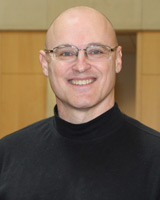 Building a “Personal Cyberinfrastructure”
Building a “Personal Cyberinfrastructure”
By: Morris Pelzel
This issue of Austin College Magazine features the new digital pedagogy initiative at the College. It’s exciting to see the many enhancements of learning that are taking place across our curriculum. From chemistry to Chinese, music to biology, psychology to history and beyond, faculty are using a diverse set of tools and applications to help students engage and connect more effectively with their subject matter, with one another, and with learners and resources beyond campus.
Beyond all of the individual projects and courses, is there an underlying vision that is propelling us forward? In our grant proposal to the Mellon Foundation, we stated that “Essentially, the College is seeking to change its culture as it builds capacity to engage in digital learning and scholarship.” That’s a bold and far-reaching claim, but what exactly does it mean? What is it about the culture at Austin College that we are seeking to change? Are we somehow abandoning our traditional and successful approach to liberal arts education and learning?
Actually, the changes we seek to bring about are intended precisely to preserve and extend what we do best—empower students to take ownership of their education and become the agents of their own lifelong learning. That has always been a hallmark of studying the liberal arts, and, in the digital world in which we now live, that task is more important than ever. As the discovery, production, and communication of knowledge has increasingly moved to digital online networks, we need to equip students to take charge of themselves as responsible participants in those networks.
In a 2009 essay, Gardner Campbell, an influential thought leader in the field of digital pedagogy, sketched out a vision of empowering students in the digital age:
How might colleges and universities shape curricula to support and inspire the imaginations that students need? Here’s one idea. Suppose that when students matriculate, they are assigned their own web servers. … As part of the firstyear orientation, each student would pick a domain name. Over the course of the first year, in a set of lab seminars facilitated by instructional technologists, librarians, and faculty advisors from across the curriculum, students would build out their digital presences in an environment made of the medium of the web itself. … They would play with wikis and blogs; they would tinker and begin to assemble a platform to support their publishing, their archiving, their importing and exporting, their internal and external information connections. They would become, in myriad small but important ways, system administrators for their own digital lives. In short, students would build a personal cyberinfrastructure, one they would continue to modify and extend throughout their college career—and beyond.
In building that personal cyberinfrastructure, students not only would acquire crucial technical skills for their digital lives but also would engage in work that provides richly teachable moments ranging from multimodal writing to information science, knowledge management, bibliographic instruction, and social networking. … Students with this kind of digital fluency will be well-prepared for creative and responsible leadership in the post-Gutenberg age. Without such fluency, students cannot compete economically or intellectually, and the astonishing promise of the digital medium will never be fully realized. [Gardner Campbell, “A Personal Cyberinfrastructure,” EDUCAUSE Review, vol. 44, no. 5 (September/October 2009): 58–59.]
Campbell’s articulation of a “personal cyberinfrastructure” has become a touchstone for the direction of pedagogy today and represents the cultural change that we are working toward at Austin College. We want to encourage our faculty and students not only to bring digital tools into their classrooms and courses but to establish themselves with a professional academic presence and portfolio in the online world. In the coming year and beyond, we will move to provide our community with the resources to make this possible.
Learning and scholarship on the web is open, connected, and augmented. As much as possible, inquiry, study, and publication should be open and accessible to the widest possible audience, preferably to the entire world. This creates opportunities for spontaneous connections, serendipitous collaborations, and unplanned discoveries. For example, a student blog post or portfolio item could be seen by someone with expertise in a given field who offers the student constructive feedback or even a professional opportunity. Openness and connectivity thus augment our intelligence; participating in networks of learning and practice amplifies what our minds are capable of.
Austin College students are renowned among other things for their global outreach and learning. The digital pedagogy initiative represents a further immersion into global networks and the World Wide Web. With a personal cyberinfrastructure, students will be well-situated to continue a long tradition of innovative learning.
Morris “Mo” Pelzel joined the Austin College community this year as digital pedagogy designer.
The content of this column expresses the perspectives of the author and do not necessarily reflect the views, position, or policy of Austin College, its administrators, or its Board of Trustees.
